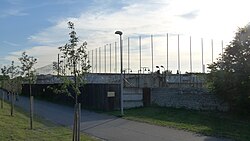HD 89571
HD 89571| 관찰 데이터 Epoch J2000.0EquinoxJ2000.0(ICRS) | |
|---|---|
| 콘스텔레이션 | 카멜로파르다리스 |
| 적경 | 10h 29m 41.6297s[1] |
| 적위 | +84° 15° 06.949°[1] |
| 겉보기 등급(V) | 5.51±0.01[2] |
| 특성. | |
| 스펙트럼형 | A9 V[3] |
| U-B 색지수 | +0.06[2] |
| B-V 색지수 | +0.23[2] |
| 아스트로메트리 | |
| 반지름 속도(Rv) | 3.5±2km[4]/s |
| 고유운동(μ) | RA: -180.124 mas/yr[1] Dec.: - 21.494 mas/yr[1] |
| 시차()) | 23.0490 ± 0.3729 mas[1] |
| 거리 | 142 ± 2y (43.4 ± 0.7 pc) |
| 절대 등급(MV) | +2.48[5] |
| 궤도[6] | |
| 기본적인 | A |
| 동반자 | B |
| 기간(P) | 2.20±0.03년 |
| 반장축(a) | 0.0142±0.0006 °C |
| 편심(e) | 0.26±0.11 |
| 세부 사항 | |
| A | |
| 덩어리 | 1.69[7] M☉ |
| 반지름 | 1.79[1] R☉ |
| 광도 | 8.4[8] L☉ |
| 표면 중력(log g) | 4.27kg[9] |
| 온도 | 7,535[10] K |
| 금속성 [Fe/H] | +0[11].04덱스 |
| 회전 속도(v sin i) | 134±7km[10]/s |
| 나이 | 710Myr[7] |
| B | |
| 덩어리 | 0.38[7] M☉ |
| 기타 명칭 | |
| 데이터베이스 참조 | |
| 심바디 | 데이터. |
HD 89571(HR 4062)은 북반구 극주위 낙타자리에 있는 쌍성이다[12].이 행성은 총 겉보기 등급 5.51로[2] 육안으로 희미하게 보이고 태양계로부터 142광년[1] 떨어진 것으로 추정된다.그러나 태양중심 반경속도 3.5km/[4]s로 후퇴하고 있다.
주성의 분광형은 A9 [3]V로 일반적인 A형 주계열성임을 알 수 있다.데이비드 S. 에반스는 A6[13] V의 약간 따뜻한 등급을 준 반면 카울리 등은 F형 준거성을 나타내는 F0 [14]IV로 분류했다.그럼에도 불구하고, 두 성분은 평균 14.2 [6]밀리초 간격으로 서로를 공전하는 데 약 2년이 걸린다.
성분의 질량은 1.69☉ M과 0.38☉ [7]M이며, 질량은 M형 별일 가능성이 있습니다.HD 89571의 반지름은 1.79☉[1] R, 광도는 8.4☉ [8]L입니다.이것은 유효 온도 7,535 [10]K를 산출하여 흰색을 나타냅니다.이 별의 나이는 7억 1천만 년으로[7] 추정되며, 자전 속도는 134 km/[10]s로 빠르게 회전합니다. 태양에 가까운 금속성을 가지고 있으며,[11] 이는 태양의 110%에 해당합니다.
레퍼런스
- ^ a b c d e f g VizieR에서 이 소스에 Brown, A. G. A.; et al. (Gaia collaboration) (August 2018). "Gaia Data Release 2: Summary of the contents and survey properties". Astronomy & Astrophysics. 616. A1. arXiv:1804.09365. Bibcode:2018A&A...616A...1G. doi:10.1051/0004-6361/201833051.대한 Gaia DR2 레코드.
- ^ a b c d Oja, T. (August 1991). "UBV photometry of stars whose positions are accurately known. VI". Astronomy and Astrophysics Supplement Series. 89: 415. Bibcode:1991A&AS...89..415O. ISSN 0365-0138.
- ^ a b Abt, Helmut A.; Morrell, Nidia I. (July 1995). "The Relation between Rotational Velocities and Spectral Peculiarities among A-Type Stars". The Astrophysical Journal Supplement Series. 99: 135. Bibcode:1995ApJS...99..135A. doi:10.1086/192182. ISSN 0067-0049.
- ^ a b Evans, D. S. (1967). "The Revision of the General Catalogue of Radial Velocities". International Astronomical Union. 30: 57. Bibcode:1967IAUS...30...57E.
- ^ Anderson, E.; Francis, Ch. (2012). "XHIP: An extended hipparcos compilation". Astronomy Letters. 38 (5): 331. arXiv:1108.4971. Bibcode:2012AstL...38..331A. doi:10.1134/S1063773712050015. S2CID 119257644.
- ^ a b Malkov, O. Yu.; Tamazian, V. S.; Docobo, J. A.; Chulkov, D. A. (October 2012). "Dynamical masses of a selected sample of orbital binaries". Astronomy & Astrophysics. 546: A69. Bibcode:2012A&A...546A..69M. doi:10.1051/0004-6361/201219774. eISSN 1432-0746. ISSN 0004-6361.
- ^ a b c d e De Rosa, R. J.; Patience, J.; Wilson, P. A.; Schneider, A.; Wiktorowicz, S. J.; Vigan, A.; Marois, C.; Song, I.; Macintosh, B.; Graham, J. R.; Doyon, R.; Bessell, M. S.; Thomas, S.; Lai, O. (26 November 2013). "The VAST Survey – III. The multiplicity of A-type stars within 75 pc". Monthly Notices of the Royal Astronomical Society. 437 (2): 1216–1240. arXiv:1311.7141. Bibcode:2014MNRAS.437.1216D. doi:10.1093/mnras/stt1932. eISSN 1365-2966. ISSN 0035-8711.
- ^ a b Chandler, Colin Orion; McDonald, Iain; Kane, Stephen R. (17 February 2016). "The Catalog of Earth-Like Exoplanet Survey Targets (CELESTA): A Database of Habitable Zones Around Nearby Stars". The Astronomical Journal. 151 (3): 59. arXiv:1510.05666. Bibcode:2016AJ....151...59C. doi:10.3847/0004-6256/151/3/59. eISSN 1538-3881.
- ^ Allende Prieto, C.; Lambert, D. L. (December 1999). "Fundamental parameters of nearby stars from the comparison with evolutionary calculations: masses, radii and effective temperatures". Astronomy and Astrophysics. 352: 555–562. arXiv:astro-ph/9911002. Bibcode:1999A&A...352..555A. ISSN 0004-6361.
- ^ a b c d Reiners, A. (January 2006). "Rotation- and temperature-dependence of stellar latitudinal differential rotation". Astronomy & Astrophysics. 446 (1): 267–277. arXiv:astro-ph/0509399. Bibcode:2006A&A...446..267R. doi:10.1051/0004-6361:20053911. eISSN 1432-0746. ISSN 0004-6361.
- ^ a b Netopil, Martin (4 May 2017). "Metallicity calibrations for dwarf stars and giants in the Geneva photometric system". Monthly Notices of the Royal Astronomical Society. 469 (3): 3042–3055. arXiv:1705.00883. Bibcode:2017MNRAS.469.3042N. doi:10.1093/mnras/stx1077. eISSN 1365-2966. ISSN 0035-8711.
- ^ Eggleton, P. P.; Tokovinin, A. A. (11 September 2008). "A catalogue of multiplicity among bright stellar systems". Monthly Notices of the Royal Astronomical Society. 389 (2): 869–879. arXiv:0806.2878. Bibcode:2008MNRAS.389..869E. doi:10.1111/j.1365-2966.2008.13596.x. eISSN 1365-2966. ISSN 0035-8711.
- ^ Evans, D. S. (1966). "Fundamental data for Southern stars (6th list)". Royal Greenwich Observatory Bulletins. 110: 185. Bibcode:1966RGOB..110..185E.
- ^ Cowley, A.; Cowley, C.; Jaschek, M.; Jaschek, C. (April 1969). "A study of the bright stars. I. A catalogue of spectral classifications". The Astronomical Journal. 74: 375. Bibcode:1969AJ.....74..375C. doi:10.1086/110819. ISSN 0004-6256.


